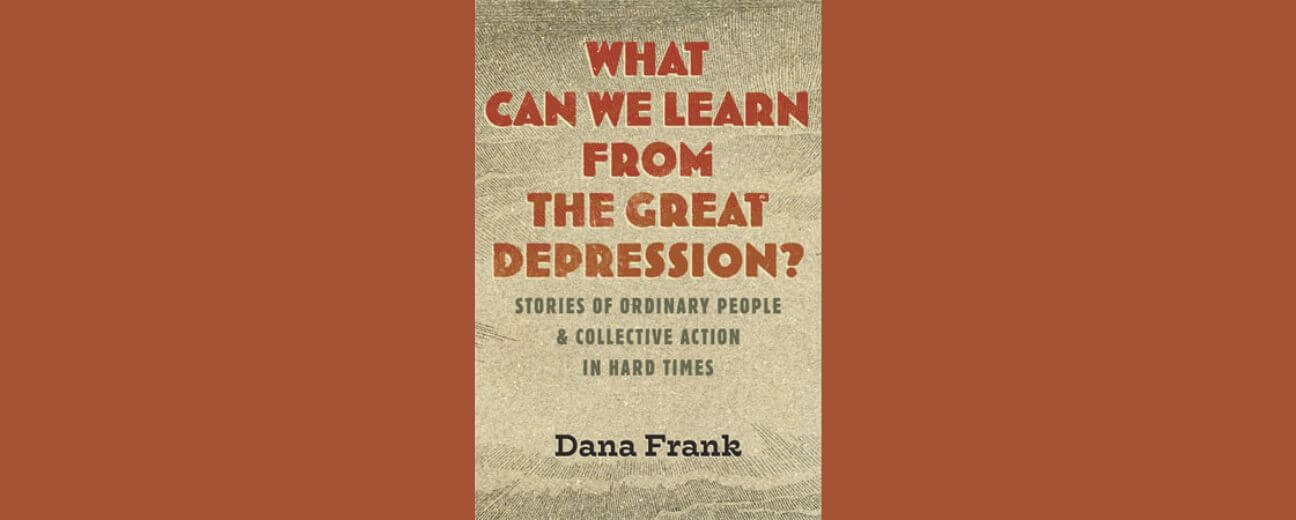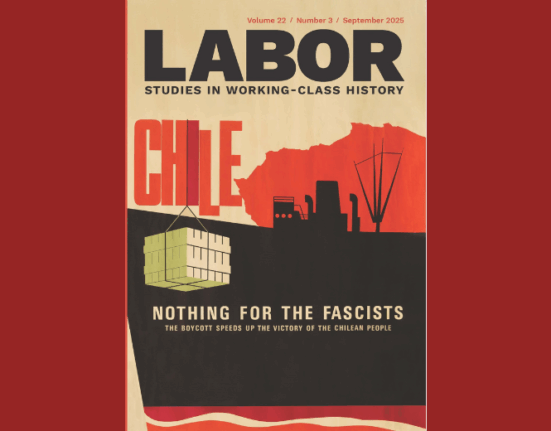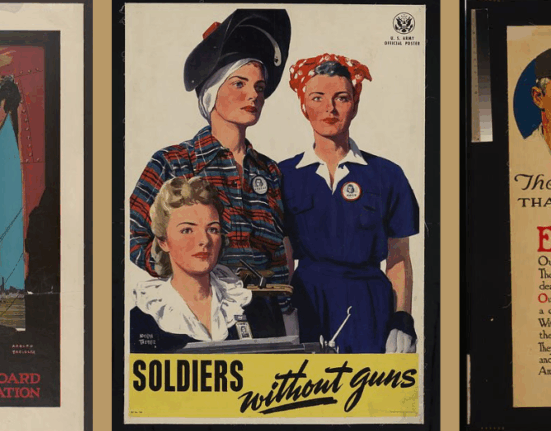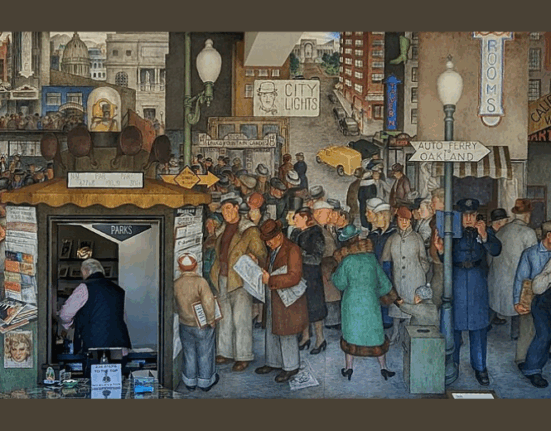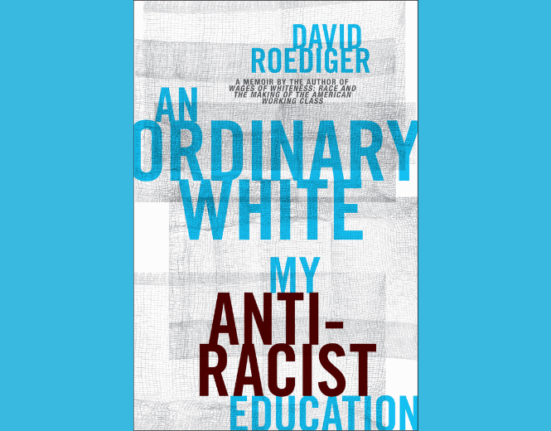Dana Frank’s What Can We Learn From the Great Depression: Stories of Ordinary People & Collective Action in Hard Times shares four Great Depression episodes that dramatically and poignantly show how ordinary working people responded to the ongoing crisis by engaging in creative, collective action. Randi Storch interviewed her about the book and its meaning.
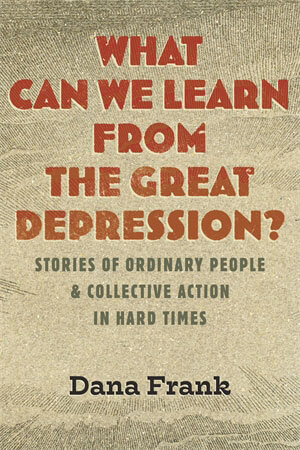
Your book What Can We Learn From the Great Depression: Stories of Ordinary People & Collective Action in Hard Times is a powerful account that makes visible collective actions that are not a part of mainstream accounts of the Great Depression.
What inspired you to write this book, and how did you come to settle on these four experiences?
Thank you so very much for this interview, Randi. I’m honored, and a big fan of your own work.
After spending more than a dozen years working on human rights and US policy in Honduras, I was deeply exhausted, to be honest, from the intensity of fighting US imperialism and the State Department in live time. And with the rise of Trump, I wanted to return to using my US history writing skills to fight racism at home. I knew I wanted to write about the 30s–I’d been teaching a class on the Great Depression for years, as well as teaching it in my labor history classes all along. Originally, I started with the question of whether the New Deal had stopped fascism in the 1930s. That drew me into studying the Black Legion.
I decided to write a series of separate essays on the 30s, following my instincts about whatever I felt like writing about. Originally there were going to be seven chapters. But after the first one I wrote came in at 80 pages in manuscript form, I realized I’ve always liked writing longer pieces–sort of nonfiction novellas. The storytelling potential is much greater; you can move in and out of contexts, telling stories within stories, connecting broader dots. You can also set up juxtapositions and play with them. But it’s harder work as a writer, because while you’re writing the first draft you have to carry that storytelling conversation with the reader in your head for weeks and weeks, without stopping to put it down. It helps that I am obsessive outliner.
I was stunned–here were some of the most hyperexploited, invisible workers imaginable, acting with amazing militance. I saved the clipping, and always remembered them.
I knew from the beginning that I wanted to tell the story of the seven young Black women who worked as wet nurses for the City of Chicago, who occupied the office of the Board of Health in City Hall for two days. I originally saw their photo twenty-five years ago, in a 1937 issue of Life magazine when I was researching the Woolworth’s sit-down strike. I was stunned–here were some of the most hyperexploited, invisible workers imaginable, acting with amazing militance. I saved the clipping, and always remembered them. Researching that chapter was an entire education for me, unpacking their lives, their work, and the sources of their power in Chicago’s South Side, which was exploding with political energy at the time. It was a powerful challenge for me, as a white woman, to try to understand their lives and their world view, pieced together from scraps of evidence, and building from the tremendous secondary literature we now have about Black Chicago in the period.
The second chapter, “A Tale of Two Caravans,” contrasts erasure of the mass repatriation of Mexican and Mexican Americans, with the classic exaltation of white, in many ways mythical white “Dust Bowl” migrants. It came in part from my labor history teaching. For years, I’d assigned Balderrama and Rodríguez’s Decade of Betrayal, and lectured about California farm labor, including Steinbeck’s racism and the problems with white-centered narratives of individualized suffering during the Great Depression. When I chose to write about Repatriation, I also very consciously wanted to place immigration politics front and center in narratives of the Great Depression, where it’s usually ignored. By framing the story as two “caravans,” I was deliberately invoking contemporary immigration.
I wanted readers to know about successful eviction protests, massive marches demanding relief, and occupations of welfare offices, largely before the New Deal stepped in. I wanted them to know about the racial politics of these movements, both the Communists’ anti-racism and interracial activism, and the Socialists’ white-centered politics and exclusion of immigrants
The book’s first chapter was very much designed to reach younger activists at their starting point, as well as to set up some of the key themes of the book. Many, many people today are committed to mutual aid, and want to know its history. So I looked for different forms of mutual aid in the 30s, and settled on mutual benefit associations (they might seem boring and old-fashioned, but were in fact rife with socialists and anarchists. And consumer cooperatives, which sprang up everywhere, and raise thorny questions about grassroots democratic practices (and sexism, alas.) The chapter’s second half very deliberately points readers toward a very different path working people chose: making militant demands on the state. I wanted readers to know about successful eviction protests, massive marches demanding relief, and occupations of welfare offices, largely before the New Deal stepped in. I wanted them to know about the racial politics of these movements, both the Communists’ anti-racism and interracial activism, and the Socialists’ white-centered politics and exclusion of immigrants.
Throughout the writing of the book, it was very intellectually challenging to keep all the analytical balls in the air: to make it a story equally about women and men, looking clearly at the dynamics between them; to place multiple different racial-ethnic groups front and center, and in dialogue and relation to each other. We have so few models of books that do this.
When I was done, I realized I was depicting a 1930s very different from the world we celebrated during the 1970s and 80s, when so much great scholarship was produced through which we learned about, and imagined, progressive struggles for social justice. In my book, I still look to the Great Depression for inspiring stories of creative militancy. But now repression of immigrants looms more clearly; as does organized working-class fascism. Living through a period of “crisis” resonates differently.
Each chapter is beautifully written and introduces your reader to new ways of seeing and thinking about its protagonists and the lessons they offer to us today. Your book teaches us about the ways ordinary people provided themselves with necessities, from food to funerals. You show how the stories of repatriation among people of Mexican descent and movement of dust bowl migrants west are two sides of the same coin. You bring us into the circle of seven black wet nurses who engaged in a sit-down strike to increase the rate they were paid per ounce for their bodily fluid and the larger context shaping their decision. Finally, you introduce us to the Black Legion and the people and events who facilitated their fall. Considering this rich collection of people and organizations, who are some of the people and the stories that you found most fascinating, troubling, or heroic?
Oh, thank you for asking! There are so many people in the book I love, and amazing stories I got to recount. One of my favorites is Willye Jeffries’s story of a struggle in Chicago, in which Black and white protesters were trying to shake loose a burial payment from the welfare office One of the picketers was a large white woman named Ma Kuntz, who kept time out front with a big stick. When the protesters sent a fake corpse into the office, the social workers fled upstairs. So the protesters occupied the downstairs. At lunchtime, the social workers sent down money to buy food. Finally the cops showed up, but when they saw Ma Kuntz at the door keeping time with her stick, they were out of there. The protesters camped out in the office for two weeks, brought in a piano, and had a great time. Then they won. I also love the story of Mrs. Ruby Lucas, who sat on a mattress on her front stoop for three days in a squirrel coat and bedroom slippers, sipping coffee, and refused to be evicted. She said she was “warring on the millionaire bankers.”
Another one of my favorite characters is a white farmer in Lima named William H. Smith. You can see him in his overalls smiling away in a New York Times photo. When hundreds of hooded Black Legion member held him captive on a farm and tried to force him at gunpoint to swear fealty, he yelled back and denounced them, even when he was tied up and dumped into a corn crib. He said the other “recruits” were too terrified to refuse; “Their teeth was crackin’ together like a hog eatin’ charcoal.” When Smith was finally allowed to run away, his captors threatened to kill him if he talked. He told the sheriff the next day. My hero!
I loved the lists of what ordinary, usually poor people donated: nickels, dimes, loaves of bread, tools. . . The “young ladies” who worked at Woolworth’s donated two hundred glasses of milk. How often can we feel, across time, the love and solidarity embodied in those hundreds of gifts from ordinary people?
I was also deeply moved by the ways the Mexican communities in San Antonio and Laredo, Texas, and Nuevo Laredo, Mexico came to the aid of repatriado families passing through on their way over the border. Well-wishers lined the streets, waving, as caravans of migrants passed by; they cooked food; they drove people to the train station in their cars and trucks. I loved the lists of what ordinary, usually poor people donated: nickels, dimes, loaves of bread, tools. For a fundraising raffle, they donated a manicure case, six jars of brilliantine hair cream, a shirt, tire patches. The “young ladies” who worked at Woolworth’s donated two hundred glasses of milk. How often can we feel, across time, the love and solidarity embodied in those hundreds of gifts from ordinary people?
And of course the wet nurses’ strike is the most amazing story of all time. I also loved so many little stories. Don’t make me choose! Pablo Baiza, who crossed the Rio Grande into Mexico with his burro wagon and said he was sick of being harassed by US authorities. Bertha Marmo and her cooperative of white women washing laundry while singing church songs. The eleven interracial “marriages” among Black, Filipino, Mexican, white, and Native Alaskan gay men in Seattle’s Hooverville encampment. The Jewish women rent strikers with their hissing teakettles.
Typically stories of collective action in the 1930s focus on the activism of groups pushing to expand democratic and civil rights. You decided to write a chapter on the Black Legion. Why, and what do you hope your readers will come to understand about the meaning and significance of collective action during the depression (and today)?
I deliberately wanted to place white working-class fascism on the list of 1930s activism–not just look at uplifting forms of activism we want to emulate. In the context of white working-class support for Trump and Trumpism, we obviously need to understand the roots of how white working-class people, especially men, turn to this kind of hateful, vicious attack on other working people, rather that pointing upward at the roots of the problem. We know there’s a long history not only of racism but also antisemitism, anti-Catholicism, and armed hatred running through US history. In Lima, Ohio, the headquarters of the Black Legion, one in four or five white men (and a few women) joined, along with the mayor, police chief, and the county prosecutor. I was lucky to have rich primary sources–oral histories, extensive FBI investigations, national media coverage, and much more–so I was able to unpack the Legion’s appeal, especially to skilled working-class men, to the plumbers, factory foremen, carpenters of the classic “labor aristocracy.” Here the troubling characters lurk, and their terrifying work–burning down roadhouses, whipping people, plotting to gas the entire US Jewish population–led by a glum, fishy electrician named Virgil Effinger. I was also able to trace pushback to the Legion, locally and nationally, and how the Legion was successfully defeated.
But much of the “activism” in the book is, rather, collective community survival–the caravans of thousands of people traveling to Mexico; the community support for their passage; or, in the Black Legion chapter, the community survival strategies of Lima’s African Americans and Italians.
When the book was done, and I had to write an introduction and help my publisher promote it, it was challenging to come up with a conceptual vocabulary that fit all the chapters. The stories aren’t all about working-class “organizing” or “militance” or even “activism,” in the traditional positive sense. The Black Legion clearly doesn’t fit. But the caravans chapter doesn’t either. It does include, centrally, the story of militant labor activism by Mexican and Filpino workers in the California fields. But much of the “activism” in the book is, rather, collective community survival–the caravans of thousands of people traveling to Mexico; the community support for their passage; or, in the Black Legion chapter, the community survival strategies of Lima’s African Americans and Italians. I ended up using “collective action” as a concept that could embrace all the different working-class endeavors in the book.
More broadly, the book is designed to challenge us to think about what the full working-class struggle looks like–then and now. It’s not just about the “labor movement” as traditionally defined. The first chapter, about mutual aid, cooperatives, and the unemployed movement, addresses working-class people’s activism to obtain food, housing, burial insurance, and other necessities outside of the sphere of paid employment, which had largely failed them (or failed to employ women at all). At a theoretical level, the chapter is underscoring the full range of working people’s economic needs, not just their need for wages with which to obtain them. Housework, and hence women’s unwaged labor, is therefore central, and women’s activism in this sphere.
My interest in all this goes way back: In 1981, I wrote my very first graduate research paper about eviction protests in the 1930s; and the next on Jewish women’s food protests during World War I. My first book was about what happened when the labor movement tried to make shopping political, as part of the class struggle.
The wet nurses’s chapter is entitled “Whose Labor Movement?” for similar reasons. What does a labor movement look like if it takes into account, and fully makes central, women’s reproductive labor in the home, whether waged or unwaged? How do we make women of color’s historic, and contemporary, work in domestic labor, central to our entire definition of the labor movement, not at some fringe?
Ordinary people and their collective actions are front and center of your work and at the same time each chapter offers a critical connection to the role of the state, its actors and policies. What is the main lesson you hope your readers take away about the role of collective action in transforming the state into an actor that serves as a force for the public good?
When I started this project, I thought it was going to be about how working-class activism from below made the New Deal happen. Organizing works! And yes, that was true of the unemployed movement that I write about at length. Without question it brought us federal unemployment insurance. Or, more accurately, it brought some of us federal unemployment insurance, depending on our race and gender position in the economy. But other than that, the impact on the state of the book’s organizing campaigns is harder to map. Mass protests of all kinds have impacts and ripple effects that are often impossible to trace. The Communist Party organized enormous demonstrations demanding unemployment relief nationwide in March, 1930–a mere six months after stock market crash–and involved tens of thousands of Black and white and other people in dozens of cities. They were brutally repressed. But we can imagine the memory of those protests, and how the elites might have feared a revolution (it was less than a decade after Russia’s, remember) for the rest of the 1930 and, as a result, accepted the New Deal, if reluctantly.
The Black Legion certainly scared a lot of people in Washington, and nationwide, but Roosevelt and J. Edgar Hoover evidently didn’t prosecute or denounce it because so many Southern Democrats in Congress, on whom FDR depended to pass the New Deal, were KKK members. The wet nurses, for their part, were one piece of the immense labor uprisings of the mid- and late 1930s that both led to the National Labor Relations Act and benefited from it, but not in direct ways; rather, they were part of the complex, dynamic explosion of the labor movement of the Great Depression, in which the whole was greater than the sum of its parts.
Rather than tracing impacts, I mostly chose to explore, instead, the question of what each chapter’s groups did or didn’t get from the New Deal. When I was writing the book, the call for a Green New Deal was very much on the table. I knew many people in their 20s and 30s who were committed to it, but who didn’t know very much about what the original New Deal actually was. I wanted to provide basics about the New Deal welfare state and its labor systems–to lay out the tremendous gains they represented for the working class, but also to be very clear about their race and gender limitations. Married working-class women in the unemployed movement, such as Ma Kuntz and Ruby Lucas, were largely excluded from the new welfare state. The wet nurses weren’t covered by the National Labor Relations Act, Social Security, unemployment insurance, or the new federal minimum wage. Farmworkers weren’t either; only white ones could stay at those nice new government migrant camps erected by the Farm Security Administration. But the New Deal delivered enormous benefits for the white male members of the Black Legion; it was designed precisely for people like them. I wanted young people to aim higher! And imagine a State that serves all the people.
Of course, today, with Trump’s massive attacks on the federal government, the whole context of the book has changed. The dream of a Green New Deal is far, far away.
When I gave book talks before the election, I was warning people: fascists! worse deportations! Now they are powerfully among us. But now, the book’s story of creative militance and collective survival from below also resonate in newly inspiring ways, reminding us that collective action works, and gives meaning to our lives in the face of terrifying crisis, today as in the 1930s.
Dana Frank is Research Professor and Professor Emerita of History at the University of California, Santa Cruz and a longtime historian of labor, women, and social movements in the US and beyond, always paying close attention to race and ethnicity. Frank is author of seven books, including Buy American: The Untold Story of Economic Nationalism; The Long Honduran Night: Resistance, Terror, and the United States in the Aftermath of the Coup; and, with Robin D.G. Kelly and Howard Zinn, Three Strikes: Miners, Musicians, Salesgirls and the Fighting Spirit of Labor’s Last Century.

